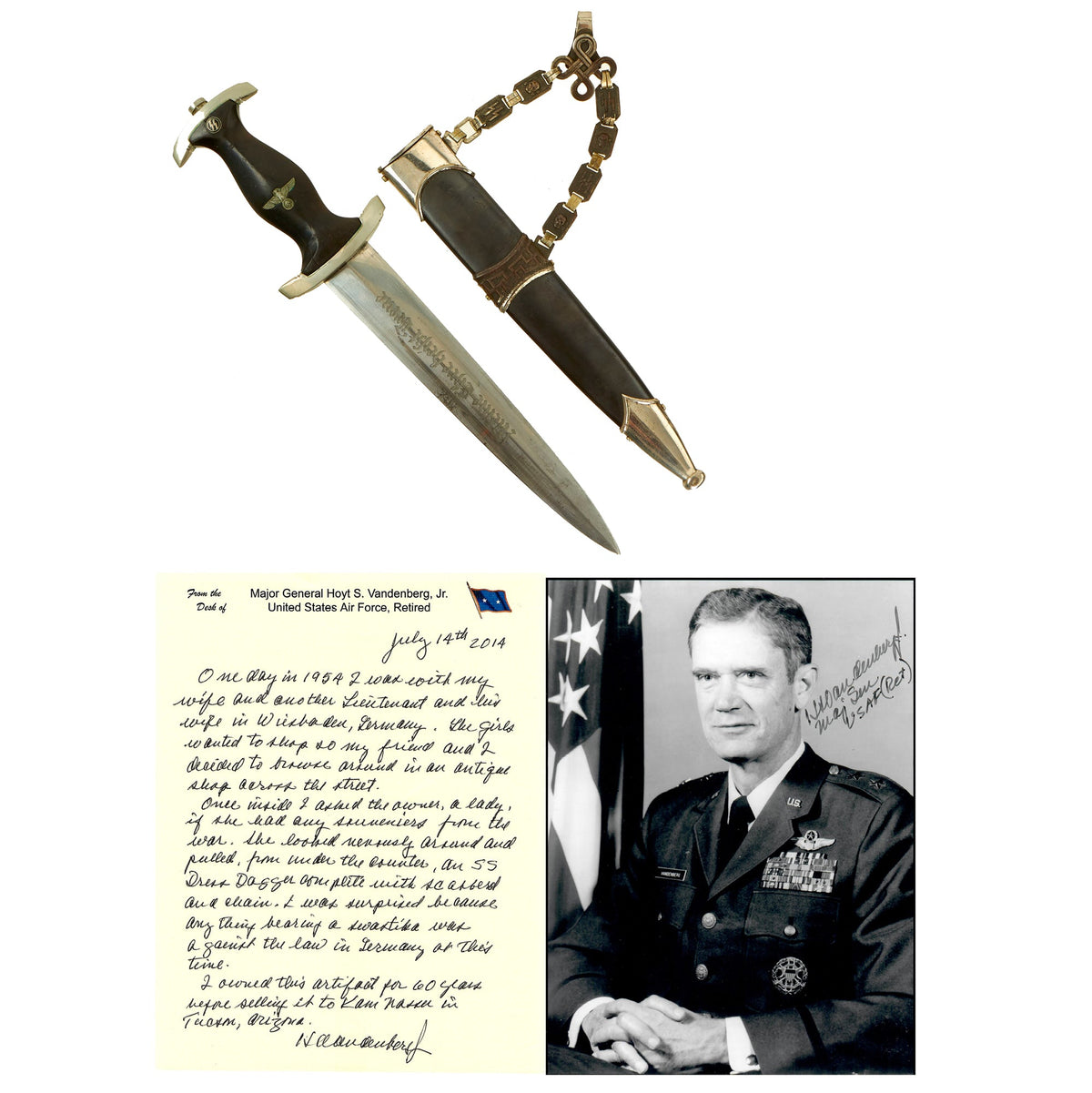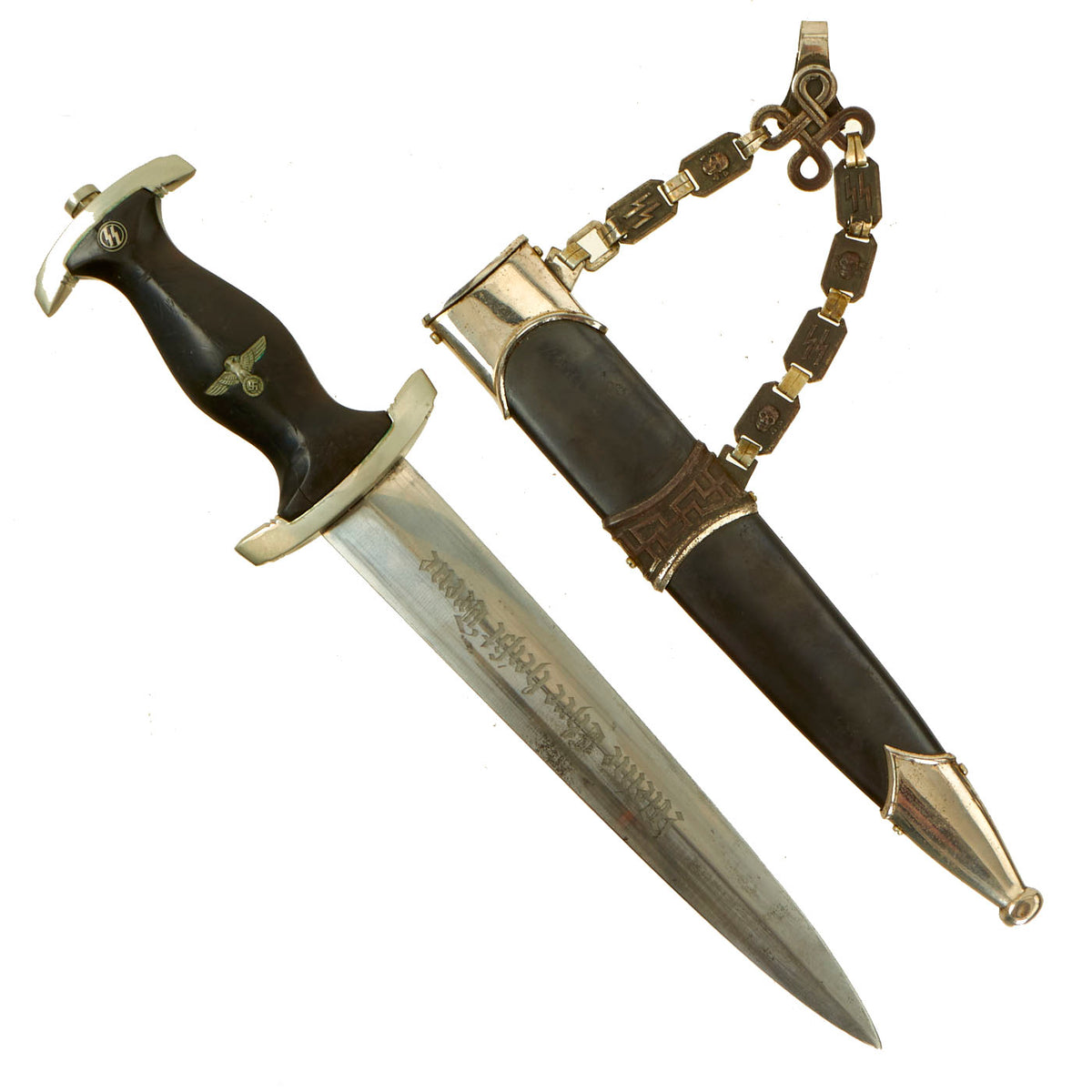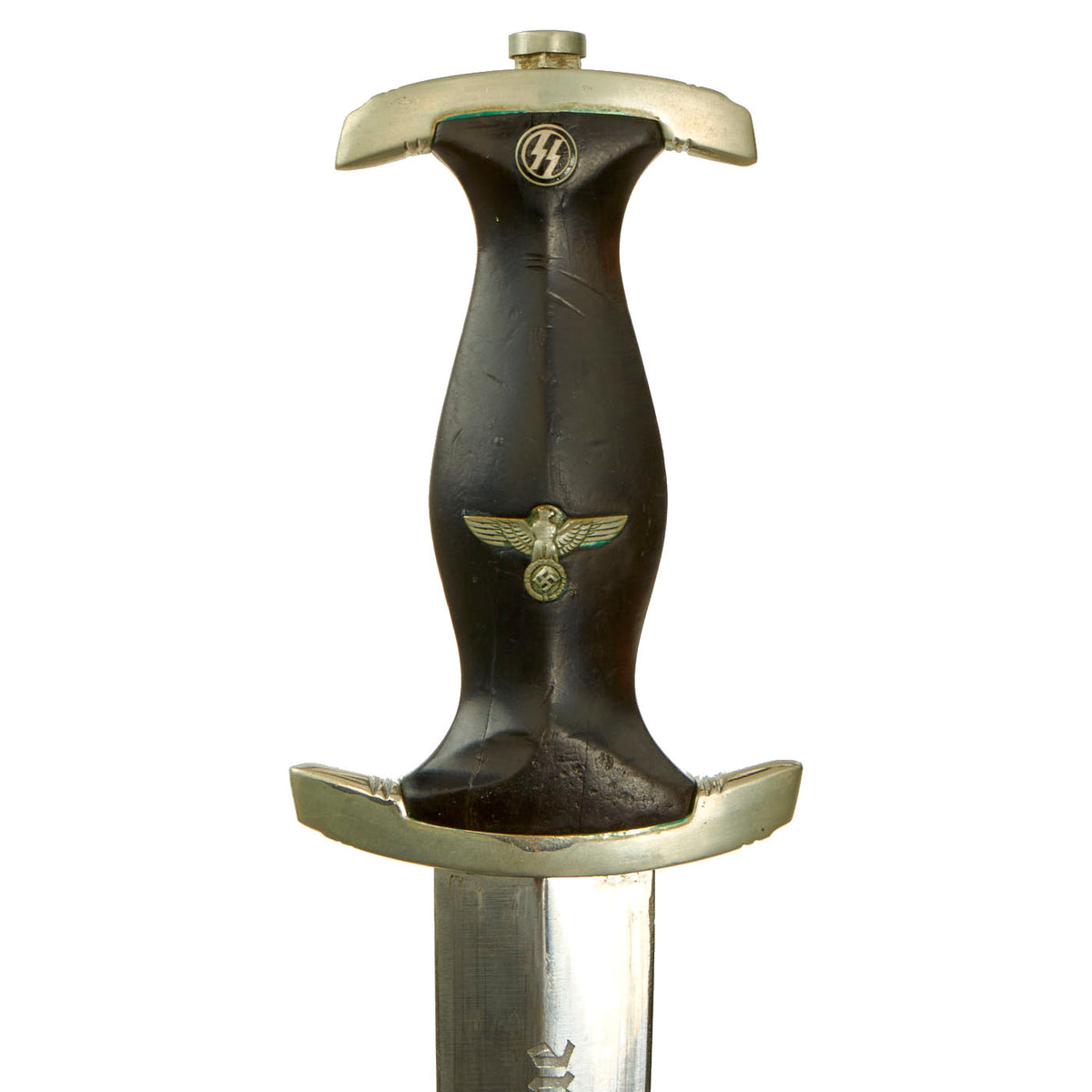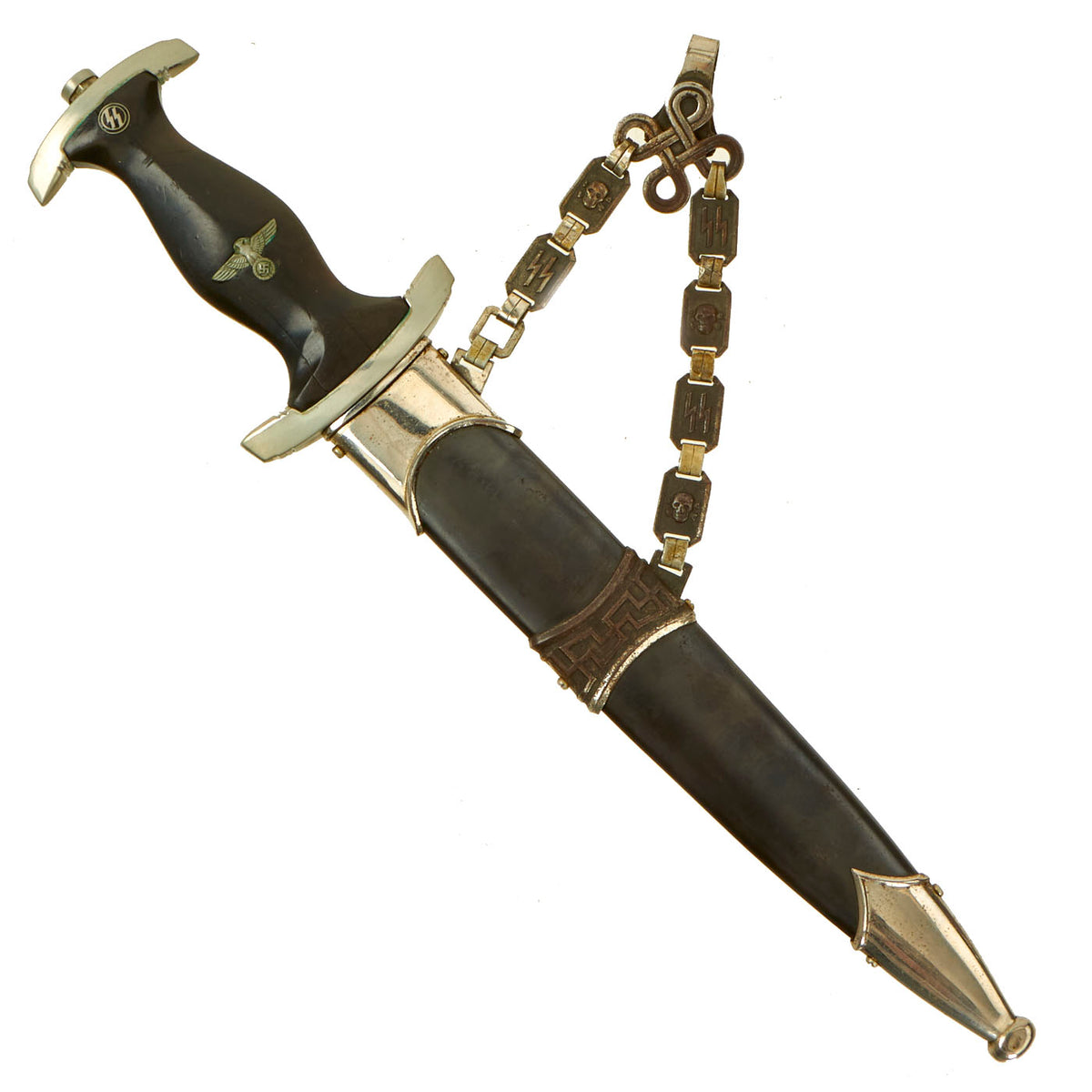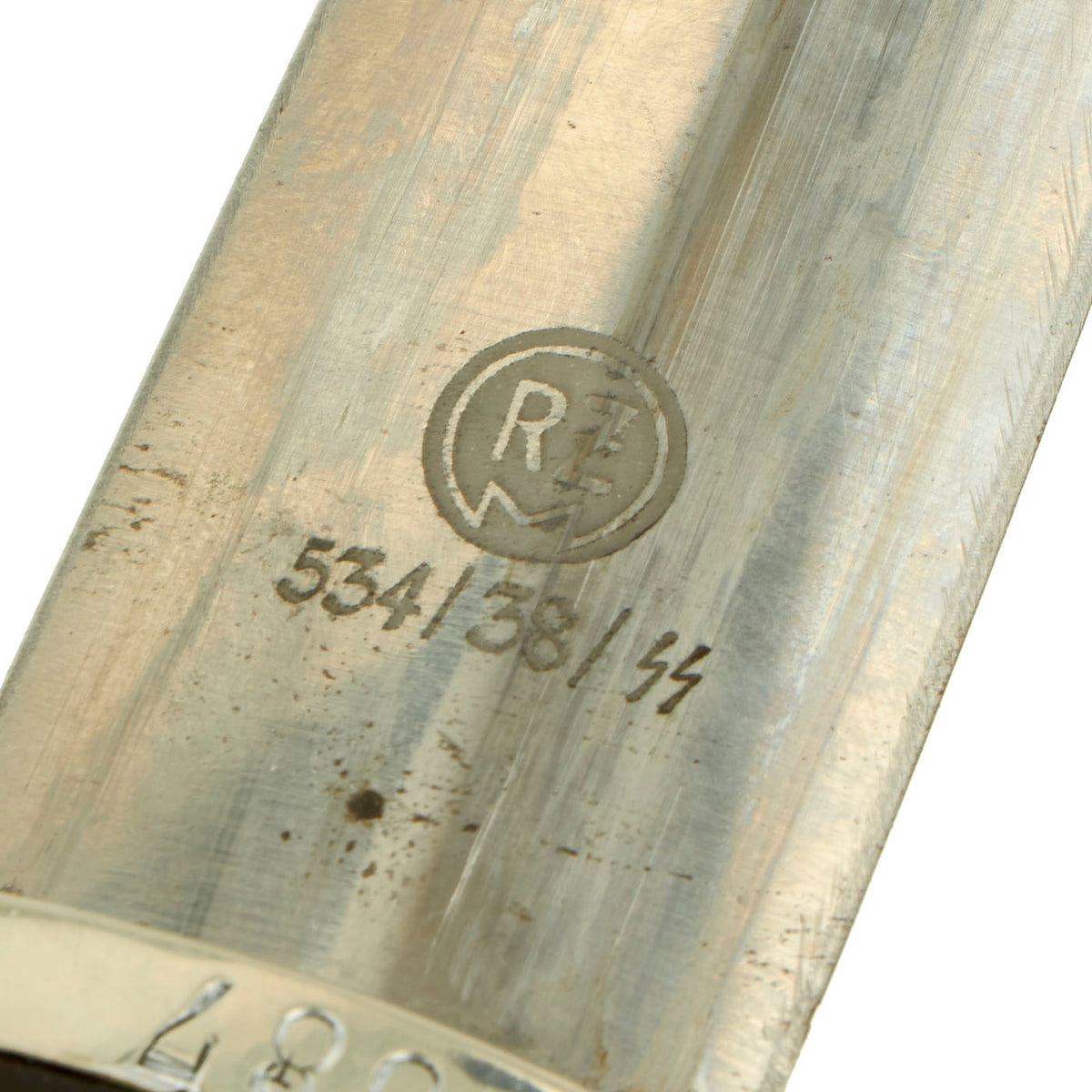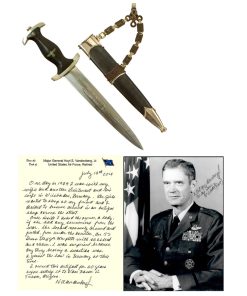Original German WWII Chained Numbered SS Dagger by Artur Schüttelhöfer Brought Back Post War by USAF Maj. Gen Hoyt S. Vandenberg, Jr. – RZM 534 / 38 / ᛋᛋ Original Items
$ 6.495,00 $ 1.623,75
Original Item: One of a Kind Bring Back Set. This is a truly exceptional find, recently purchased directly from a collector who had been in possession of this Chained SS dagger since 2014. They had acquired it directly from Major General Hoyt. S. Vandenberg, Jr. USAF (Ret’d), an accomplished aviator and former commandant of the United States Air Force Academy. During the 1950s, Vandenberg had been stationed West Germany, and whilst he was in Wiesbaden during 1954 with his wife and another officer, he acquired this dagger from an antique shop. While by this time trade in NSDAP marked items was prohibited, the shop owner pulled the SS dagger from under the counter, and the purchase was made.
Included with the dagger is a signed picture of Maj. Gen. Vandenberg, as well as a handwritten letter on his own letterhead, giving the full account, as well as indicating that the dagger was sold in 2014 to the person it was acquired from. The letter clearly mentions that it is a chained SS dagger. For more information on the general, please see his page on Wikipedia: Hoyt S. Vandenberg Jr.
This dagger is also numbered to the SS member who used it, which is No. 22 687. We have researched this number, and unfortunately were unable to locate their service information. However, No. 22 683 IS a known identified number, which indicates that this is a valid number sequence and an active portion of the SS roster. It is very possible that with further research, the original owner of the dagger may be able to be identified!
It is VERY seldom that we get bring back items with such fantastic provenance AND research potential! This will definitely be a fantastic addition to any collection!!
The SS (Schutzstaffel or Protection Squadron) was originally formed in 1925, ostensibly to act as a small, loyal bodyguard unit to protect the Führer, Adolf AH. Under the direction of the Reichsführer-SS Heinrich Himmler, the SS grew to be the most ruthless and feared organization of the 20th century. They were the vanguard of Germany eventually controlled nearly every function of German life and much of Occupied Europe.
The SS Dienstdolch (service dagger), also called the SS Ehrendolch (honor dagger), was introduced in 1933. Early on, members of the SS were awarded their daggers during a ceremony at the Feldherrnhalle Memorial in Munich. The annual ritual, charged with mysticism and meant to evoke the traditions of medieval Teutonic knights, was held on 9 November, the date of the unsuccessful Munich Putsch of 1923. Both officers and enlisted men wore the identical dagger until 1936. After this time, only enlisted men wore the M1933 dagger. After this time, only enlisted men wore the M1933 dagger, while officers and NCOs who had served 1933 and prior would receive the “Chained” version that we have here. These are quite a bit more rare and desirable than the Enlisted version.
It should be noted that as produced, the M1936 “Chained” SS daggers did not have any maker or RZM markings on the back of the dagger, and were totally unmarked. However officers and senior NCOs who already had M33 daggers often wanted to keep their original daggers, and then would save on the cost by only purchasing the chained scabbards, which were available separately to those qualified for the honor. This is why it is not uncommon at all to see maker marked daggers in Chained scabbards. For more information on this please see Exploring The Dress Daggers and Swords of the German ᛋᛋ by Thomas T. Wittmann.
The SS Dagger was originally equipped with nickel crossguards with an ebony wood grip. The black grip contained a National eagle with swas insignia recessed in the center area and an SS sigrunne button inset at the top. On early examples the scabbard shell surface was factory blackened using a metal bluing process. The scabbard had nickel mounts. The SS blade was a polished type containing the SS motto, Meine Ehre Heisst Treue (My Honor is Loyalty). Early examples were mostly hand-fit. Production of later examples was more standardized, using cheaper, nickel-plated fittings with black painted scabbard shells. They could be held with a standard belt hanger, or a much rarer vertical hanger.
The blade on this nice mid-war production dagger remains mostly bright, and is quite attractive. We often see these quite worn and oxidized, but not this example. The rear is marked with the RZM and SS contract information:
((RZM))
RZM 534 / 38 / ᛋᛋ
This marking indicates manufacture by rare maker Artur Schüttelhöfer & Co. Stahlwarenfabrik (Steelware factory) in the Wald neighborhood of Solingen, the legendary “City of Blades” in Western Germany. This company was founded in 1920, and assembled and finished daggers for political organizations and officers during the Third Reich period, per J. Anthony Carter’s excellent book GERMAN KNIFE AND SWORD MAKERS. They manufactured SA, NSKK, and SS daggers, among other items.
The blade still shows quite a lot of the original factory final polish crossgrain throughout both sides of the blade, which is certainly a rarity. This texture is iconic, and is the definitive identifying characteristic for a real WWII German Blade. It was sharpened at some point on the edge, but does not appear to have been used much at all. Aside form the sharpening and the usual runner wear, there is just a bit of light oxidation staining and scuffing, making this one of the best condition SS blades that we have handled! We would consider this blade to be in very good near excellent condition. The etched SS motto, Meine Ehre heißt Treue (My honor is loyalty) is crisp, retaining most of the factory darkened finish. The blade shoulders perfectly meet the lower cross guard contour, and has just a bit of wobble.
The crossguards of this dagger and tang nut are in good condition throughout, and as far as we can tell, are still of the early war solid nickel construction. We do not see any flaking or wear down to the base material as seen on plated examples, and there is also a faint district number I under the SS No. 22687 stamped on the reverse. The pommel nut is non magnetic, and looks to also be solid nickel alloy, with no damage from turning. We did remove the handle to check the inside of the guards a per customer requests, and the pommel guard is marked with H and X on the inside, while the cross guard is marked with H and a small symbol.
The ebony grip is a very nice example, with some cracking by both the pommel and cross guards, as well as a missing chunk by the cross guard. The ebony wood used for these grips is hard but brittle, and the staining treatment used an exacerbate this over time. Cracking is nearly ubiquitous among SS daggers, especially relatively early examples such as this. The silvered ᛋᛋ doppelte Siegrune (Double Sig/Victory Rune) symbol and double circles are in great shape, with intact plating and enamel. The grip eagle is the “high-necked” type with the beak pointing slightly up. It remains in good condition, showing very little wear, just a bit of verdigris. It looks to be either a solid nickel or nickel plated brass type.
The scabbard the dagger comes with is considered to be a Type B2, which is the type B style chain fittings made from plated steel (Type B1 used solid nickel). The shell on this example really is straight, with no dents or bends we can see. It ;has the early pattern “anodized” blue steel finish, which is protected with a lacquer coating. From what we can see, a lot of the lacquer still remains, which has protected the anodized finish from major wear and oxidation. There is just a bit of light rusting where the finish had degraded. The scabbard mounts are plated steel, and show a bit of light wear. There is a bit of denting to the lower ball, with no other splitting, denting, or other damage. The original screws all are present, and do not appear to have been messed with at all.
The center ramp fitting is the second pattern, featuring three raised intertwined swas (hook crosses) on both sides. The plating has eroded, and it now shows an oxidized patina, matching the color and patina of the Type B2 chain links. The plated brass connector tabs are all closed, and the ᛋᛋ and Totenkopf (Skull) links are all plated steel, confirmed with a magnet. The two chain assemblies are connected to a matching “Wotan’s Knot” clover leaf with a good working snap with original spring. The clover leaf is the closed type normally seen with Type II chains. The first link of the upper chain is lightly stamped with the SS-Kulturzeichen proof marking. Definitely a very nice example of this type of scabbard.
This is a fantastic one of a kind US Bring Back grouping, as well as an excellent and very rare chance to own a very good condition SS Chained Officer’s dagger by a rare maker. Ready to be the centerpiece of any WWII Edged weapon collection!
Specifications:
Blade Length: 8 3/4″
Blade Style: Double Edged Dagger
Overall length: 13 3/4”
Crossguard: 3”
Scabbard Length: 10”
The RZM, Reichzeugmeisterei, (National Equipment Quartermaster), was officially founded in June 1934 in Munich by the NSDAP, Nationalsozialistische Deutsche Arbeiterpartei, (National Socialist German Worker’s Party), as a Reich Hauptamt, (State Central Office), and was based on the earlier SA Quartermaster’s Department. The registry was was based at the Brown house in Munich and NSDAP party headquarters in Berlin.
The functions of the RZM were not only to procure and distribute items to Party formations, but also to approve chosen designs and to act as a quality control supervisor to ensure items manufactured for the Party met required specification and were standardized. Starting in late 1934 items manufactured for the SS came under the quality control of the RZM and as a result were to be marked with the RZM/SS approval/acceptance mark. The M7 in the code stands for daggers, with Robert Klaas being contractor number 37.
Shortly after this, the SS started using a separate listing of contractors, and in 1943 the Waffen-SS assumed full control over their uniform item production and no longer fell under the authority of the RZM.
Fast Shipping with Professional Packaging
Thanks to our longstanding association with UPS FedEx DHL, and other major international carriers, we are able to provide a range of shipping options. Our warehouse staff is expertly trained and will wrap your products according to our exact and precise specifications. Prior to shipping, your goods will be thoroughly examined and securely secured. We ship to thousands clients each day across multiple countries. This shows how we're dedicated to be the largest retailer on the internet. Warehouses and distribution centres can be located throughout Europe as well as the USA.
Note: Orders with more than one item will be assigned a processing date depending on the item.
Before shipping before shipping, we'll conduct a thorough inspection of the items you have ordered. Today, the majority of orders will be delivered within 48 hours. The delivery time will be between 3-7 days.
Returns
The stock is dynamic and we cannot completely manage it because multiple stakeholders are involved, including our factory and warehouse. So the actual stock may alter at any time. It's possible that you may not receive your order once the order has been made.
Our policy is valid for a period of 30 days. If you don't receive the product within 30 days, we are not able to issue a refund or an exchange.
You can only return an item if it is unused and in the same state as the day you received it. You must have the item in its original packaging.
Related products
Uncategorized
Uncategorized
Armoured Fighting Vehicles of the World: AFVs of World War One (Hardcover Book) New Made Items
Uncategorized
Uncategorized
Uncategorized
Uncategorized
Uncategorized
Uncategorized
Uncategorized
Uncategorized
Band of Brothers ORIGINAL GERMAN WWII Le. F.H. 18 10.5cm ARTILLERY PIECE Original Items
Uncategorized
Australian WWII Owen MK1 Machine Carbine SMG Custom Fabricated Replica with Sling Original Items
Uncategorized
Uncategorized
Uncategorized
Uncategorized
Uncategorized
Uncategorized
Uncategorized
Uncategorized
Armored Burgonet Helmet & Polearm from Scottish Castle Leith Hall Circa 1700 Original Items
Uncategorized
Uncategorized
Angolan Rebel 1970s era 60mm Inert Display Mortar from Angolan Civil War Original Items
